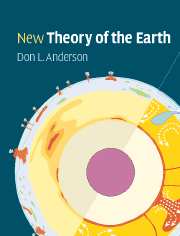Book contents
- Frontmatter
- Contents
- Preface and Philosophy
- Abbreviations and acronyms
- Part I Planetary perspective
- Part II Earth: the dynamic planet
- Part III Radial and lateral structure
- Part IV Sampling the Earth
- Part V Mineral physics
- Part VI Origin and evolution of the layers and blobs
- Chapter 23 The upper mantle
- Chapter 24 The nature and cause of mantle heterogeneity
- Chapter 25 Crystallization of the mantle
- Part VII Energetics
- References and notes
- Appendix
- Index
Chapter 23 - The upper mantle
Published online by Cambridge University Press: 05 June 2012
- Frontmatter
- Contents
- Preface and Philosophy
- Abbreviations and acronyms
- Part I Planetary perspective
- Part II Earth: the dynamic planet
- Part III Radial and lateral structure
- Part IV Sampling the Earth
- Part V Mineral physics
- Part VI Origin and evolution of the layers and blobs
- Chapter 23 The upper mantle
- Chapter 24 The nature and cause of mantle heterogeneity
- Chapter 25 Crystallization of the mantle
- Part VII Energetics
- References and notes
- Appendix
- Index
Summary
Let's descend to that blind world below. I'll go first, and you can follow
DanteOverview
The composition of the crust and the upper mantle are the results of a series of melting and fractionation events, including the high-temperature accretion of the planet. Early attempts to estimate upper mantle (UM) chemistry started from the assumption that UM initially was the same as bulk silicate Earth (BSE) and differed from it only by the extraction of the continental crust, or that the most depleted – low in LIL, U, Th, K – midocean-ridge basalts plus their depleted refractory residues – unaltered abyssal peridotites – constitute the entire upper mantle. Traditionally, geochemists have assumed that the lower mantle is undegassed BSE or primitive mantle (PM). Geodynamicists have noted that there are heat flow problems with this model, which they fixed up by putting a large amount of U, Th and K in a lower mantle stealth layer.
Large-scale melting and differentiation upon accretion probably pre-enriched the upper mantle with incompatible elements, including the radioactive elements; the crust and the various enriched and depleted components sampled by current melting events were already in the upper mantle shortly after accretion and solidification.
Recycling of crust into the upper mantle is an important current process. It is possible to estimate the composition of the fertile upper mantle by combining known components of the upper mantle – basalts, peridotites, recycled crust and so on.
- Type
- Chapter
- Information
- New Theory of the Earth , pp. 301 - 311Publisher: Cambridge University PressPrint publication year: 2007



